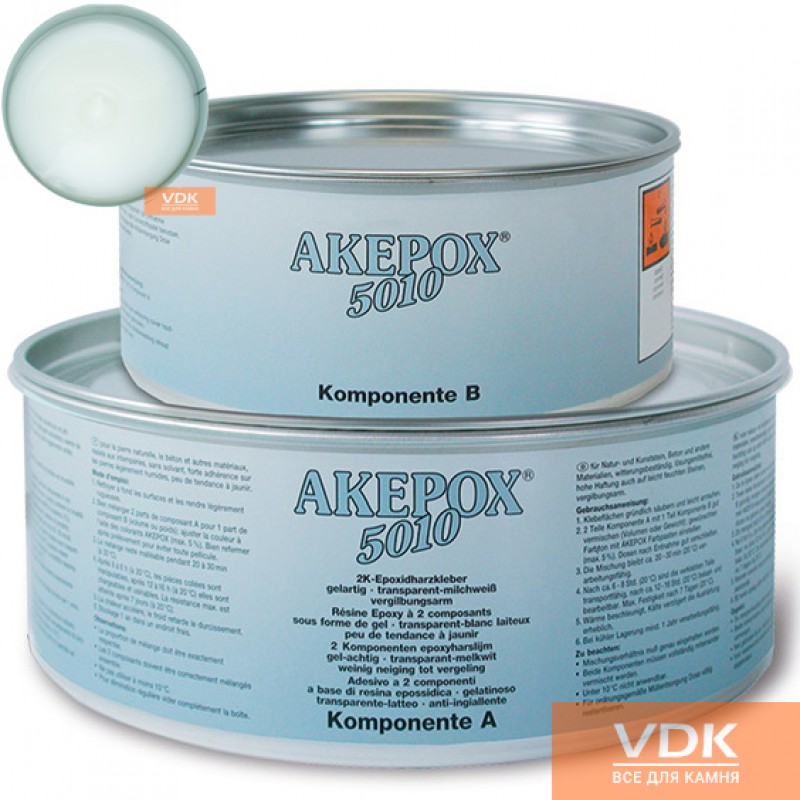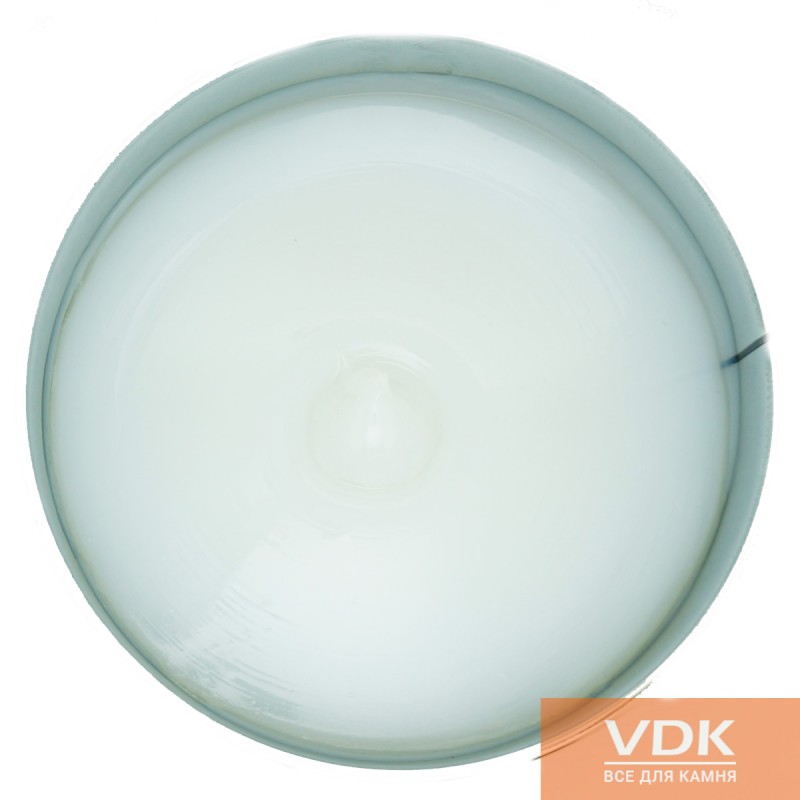Epoxy adhesive AKEPOX® 5010 2,25kg Akemi transparent
-
9 288 грн.
- Brand: Akemi - Germany
- Weight: 2.25 kg
| Characteristics | |
| Work material | marble, granite |
| Colour | transparent, milk |
| Consistency | gel |
| Manufacturer country | Germany |
| The weight | 2,25kg |
Description
Properties:
AKEPOX® 5010 is a gel-like, solvent-free, two-component adhesive based on an epoxy resin containing a cycloaliphatic polyamine hardener.
The product is characterized by the following properties:
-very neutral colour
-very low tendency to yellow
-easy dosing and mixing by use of cartridge system
-high creeping strength due to gel-like consistency
-very low shrinkage during the hardening process and therefore low tensions in the bonding layer
-weather-resistant bondings
-easy colouring with AKEPOX® Colouring Pastes or Colouring Concentrates
-good dimensional stability of the bonding layer
-low tendency to fatigue
-very good alkali-stability, thus the adhesive is very well suited to bond concrete
-excellently suited for bonding gas-impermeable materials as it is a solvent-free product
-suited for bonding load-bearing construction parts
-good adhesion on slightly humid stones
-suited for bonding materials which are sensitive to solvents (e.g. expanded polystyrene, ABS)
Application Area:
AKEPOX® 5010 is mainly used in the stone-working industry for the weather-resistant bonding and glueing of natural stone (marble, granite), Techno Ceramics as well as artificial stone or building materials (terrazzo, concrete). By means of the application of high- quality raw materials it was possible to develop a system which hardly yellows. It is thus possible to use it in combination with light-coloured or even white natural stone without the usual intensive yellowing of conventional epoxy-resin systems. Because of its supple, gel-like consistency the product has a high creeping strength on vertical surfaces. It is nevertheless possible to attain thin adhesive joints. Other materials can also be glued with AKEPOX® 5010, e.g. plastics (hard PVC, polyester, polystyrene, ABS, polycarbonates), paper, wood, glass and many other materials. AKEPOX® 5010 is not suitable for the gluing of polyolefins (polyethylene, polypropylene), silicones, hydrocarbon fluorides (Teflon), soft PVC, soft polyurethane, butyl rubber and metal.
Instructions for Use: A. Products in cans
1.Thoroughly clean and slightly roughen surfaces to be bonded.
2.Thoroughly mix 2 parts (volume or weight) of component A with 1 part (volume or weight) of component B until a homogeneous shade of colour is achieved.
3.AKEPOX® Colouring Pastes or Colouring Concentrates can be added up to max. 5%.
4.The mixture remains workable for approx. 20 - 30 minutes (20°C). After approx. 6 - 8 hours (20°C) the bonded parts may be moved, After 12 - 16 hours (20°C) approx. they may be further processed. Maximal stability after 7 days (20°C).
5.Tools can be cleaned with AKEMI® Nitro-Dilution.
6.The hardening process is accelerated by heat and delayed by cold.
Instructions for Use:
A. Products in cans
1.Thoroughly clean and slightly roughen surfaces to be bonded.
2.Thoroughly mix 2 parts (volume or weight) of component A with 1 part (volume or weight) of component B until a homogeneous shade of colour is achieved.
3.AKEPOX® Colouring Pastes or Colouring Concentrates can be added up to max. 5%.
4.The mixture remains workable for approx. 20 - 30 minutes (20°C). After approx. 6 - 8 hours (20°C) the bonded parts may be moved, After 12 - 16 hours (20°C) approx. they may be further processed. Maximal stability after 7 days (20°C).
5.Tools can be cleaned with AKEMI® Nitro-Dilution.
6.The hardening process is accelerated by heat and delayed by cold.
Special Notes: - Only if the right mixing ratio is kept, optimal mechanical and chemical properties can be obtained. A surplus of adhesive or hardener has the effect of a softener and can cause discolouration in the marginal zone.
- Single Mix cartridges are not suitable for compressed-air guns or guns with mechanical pistons.
- Two separate spatulas should be used for the adhesive and the hardener.
- An adhesive is no longer to be used if it has already thickened or is jellying.
- The product is not to be used at temperatures below 10°C because it will not sufficiently harden.
- At constant temperatures above 50°C the hardened adhesive tends to yellowing.
- The hardened adhesive can no longer be removed by means of solvents. This can only be achieved mechanically or by applying higher temperatures (> 200°C).
- The A-component slightly tends to crystallize (honey effect). The product can be made workable again by warming it up.
- The stability of the bonding depends on the natural stone to be bonded: silicate-bound stone reacts better than carbonate-bound stone.
Technical Data: 1. Colour (A and B):
2. Density (A and B):
3. Working time:
mixture of 100 g component A
+ 50 g of component B:
4. Mechanical properties:
Bending strength DIN EN ISO 178: Tensile strength DIN EN ISO 527: transparent CC 2200
approx. 1.16 g/cm³
at 10°C: 60 – 70 minutes
at 20°C: 20 – 30 minutes
at 30°C: 10 – 15 minutes
at 40°C: 5 – 10 minutes
60 - 70 N/mm²
30 - 40 N/mm²
5. Chemical Resistance Water absorption:
Sodium Chloride Solution 10%: Salt water:
Ammonium 10%:
Soda lye 10%:
Hydrochloric acid 10%:
Acetic acid 10%:
Formic acid 10%: Petrol:
Diesel oil: Lubricating oil: < 0.5 %
stable stable stable stable stable
conditionally stable conditionally stable stable
stable stable
6. Hardening process (Shore D hardness) of a 2 mm layer at 20°C:
4 h 5 h 6 h 7 h 8 h 24 h 7 d
-- 44 67 74 76 82 83
Storage: 2 years approx. under cool conditions in the firmly closed original container.
Health & Safety: Read Safety Data Sheet before handling or using this product.
Important Notice: The above information is based on the latest stage of development and application technology. Due to a multiplicity of different influencing factors, this information – as well as other oral or written technical advises – must be considered as non-binding hints. The user is obliged in each particular case to conduct performance tests, including but not limited to trails of the product, in an inconspicuous area or fabrication of
a sample piece.








